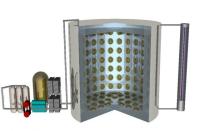
Experimental physics and observational astronomy rely on cutting-edge technologies to build detectors that push the frontier of knowledge with the data they deliver. Data is the lifeblood of science, as the scientific method demands that every insight be tested against the hard evidence of experimental data.
The art of experimentation is to provide both reliable and pertinent data to test the theories that the disciplined use of knowledge and imagination conjure from the massive body of scientific data already accumulated.
Active detector development provides the means to extend the reach of current and future experiments - and very possibly new technology that may well find its way back into your living room or workshop.
It is a vital ingredient in our quest to understand the Universe.
The detector developments that are taking place at Kavli IPMU are as diverse as the problems encountered and the individuals working on them.
- Developing a reliable scheme to add water-soluble gadolinium into the ultra-pure water volume of Super-Kamiokande. If successful, it can drastically lower the energy threshold and background for the detection of supernova relic neutrinos.
- Developing an innovative purification method of a large-volume liquid noble gas such as Argon and Xenon. These gases are used for the time projection chambers in future measurements of dark matter and neutrinos.
- Developing a multi-object spectrograph that uses optical fiber for the Subaru Telescope. It allows spectroscopic analysis of many galaxies simultaneously and, therefore, is a powerful tool for large-scale galaxy survey.
- Developing techniques for assembling, testing, mass-producing, and calibrating the silicon vertex detector that measures the decay vertices of B mesons with high resolution. Success of the Belle II experiment heavily relies on this R&D.
- Exploring ways to significantly improve the sensitivity for the dark matter search: developing high-purity germanium detector, developing techniques for coupling the photo-multiplier tube with the scintillating crystals such as sodium iodide and cesium iodide at the liquid nitrogen temperature, and developing a dark matter detector module based on ultra-pure NaI(Tl) crystals.
- Optimizing the gadolinium capture based neutron veto required in XENONnT to tag neutrons from alpha/n reactions as the neutrons leave the detector. Such neutrons might have undergone nuclear scattering inside the detector itself that otherwise might be mistaken for e.g. a WIMP recoil signal.
- Development of a polarization modulator for a space mission: the experimental challenges involve about a half-meter diameter broadband half-wave plate, sapphire, to be rotated at cryogenic temperature over three years with minimal heat dissipation. The superconducting magnetic bearing together with the cryogenic AC motor enables smooth rotation at the cryogenic temperature. Also the broadband anti-reflection functionality is achieved with a laser machining moth-eye structure, and its development is in progress for LiteBIRD.
- Development of a telescope system for CMB experiment: testing an optics with a superconducting transition edge sensor (TES) bolometer array for a space and ground CMB telescope is also in progress.
(Last update: 2018/05/31)
Members
- Shunsuke Adachi
- Hugo Allaire
- Patrick De Perio
- Sanshiro Enomoto
- Tommaso Ghigna
- Mark Hartz
- Saeko Hayashi
- Yoshinari Hayato
- Masashi Hazumi
- Takeo Higuchi
- Katsuki Hiraide
- Hirokazu Ishino
- Kookhyun Kang
- Miho Katsuragawa
- Kai Martens
- Lluis Marti Magro
- Tomotake Matsumura
- Yuta Michimura
- Marta Monelli
- Yuki Moritani
- Guillermo Pascual Cisneros
- Yuki Sakurai
- Hiroyuki Sekiya
- Yevgeny Stadnik
- Naoto Takayama
- Volodymyr Takhistov
- Naoyuki Tamura
- Ka Ming Tsui
- Mark Vagins
- Kiyoto Yabe
- Masaki Yamashita
- Naoki Yasuda
- Hiroki Yoneda






